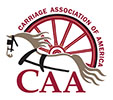
Q. In an old magazine I saw a reference to driving three horses tandem. I have always understood a tandem to be two horses driven one behind the other, and three driven in this way to be a ‘randem.’
A. The word “tandem” is a Latin word meaning “at last” or “at length.” It is thought to have first been used to describe two horses in line in the 18th century in England, but using the Latin meaning, it seems perfectly correct to speak of three or four, or any number, driven tandem. However, the word by itself is now generally understood among horsemen as meaning a team of two in a line.
The word “randem,” sometimes spelled “random,” is a cant word invented about seventy years ago for three horses driven in line. In “Riding and Driving,” published in New York in 1905, Price Collier puts the whole subject in its place as follows:
“Ambitious parties who always aim to exceed recognized standards, essay to drive a tandem of three or four horses, which they style ‘trandom’ or ‘random’ – a straining after effect in name as well as performance. As any number of single horses, not less than two, harnessed in a single line, are properly described as a tandem, such aspirants for fame, having a name provided for their turnout, may be concerned solely lest they find themselves with too many horses and two few hands for driving them. In my lexicons of coaching and driving, no application of ‘trandom’ or ‘random’ is found, and, unless the parties have a dictionary of their own, I do not believer there is any authority for such use of the words. A tandem of two horses, of which the leader turns around and faces the cart, may be said to be at random.”
A modern French writer give another derivation of the word “tandem”;
“The name comes from that of Lord tandem, a fifteenth century riding master, who invented this combination of driving in front of a one-horse carriage his own dressage horse which obeyed perfectly in long reins all the movements asked of it.”
Modern books on the British peerage show no living bearer of the title “Lord Tandem.” Perhaps the fifteenth century one did not survive long enough to leave an heir!
From The Carriage Journal, Vol 21, NO 1, Summer 1983.
